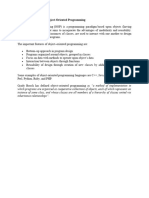0% found this document useful (0 votes)
6 views3 pagesOOP Concepts Overview
Object-Oriented Programming (OOP) is a programming paradigm that organizes software using objects and classes, emphasizing modularity and reusability. Key concepts include objects, classes, data abstraction, encapsulation, inheritance, polymorphism, and dynamic binding, which together facilitate the modeling of real-world entities and enhance code flexibility. OOP allows for efficient code management by grouping related data and methods, promoting code reuse and adaptability.
Uploaded by
suranmaity17Copyright
© © All Rights Reserved
We take content rights seriously. If you suspect this is your content, claim it here.
Available Formats
Download as PDF, TXT or read online on Scribd
0% found this document useful (0 votes)
6 views3 pagesOOP Concepts Overview
Object-Oriented Programming (OOP) is a programming paradigm that organizes software using objects and classes, emphasizing modularity and reusability. Key concepts include objects, classes, data abstraction, encapsulation, inheritance, polymorphism, and dynamic binding, which together facilitate the modeling of real-world entities and enhance code flexibility. OOP allows for efficient code management by grouping related data and methods, promoting code reuse and adaptability.
Uploaded by
suranmaity17Copyright
© © All Rights Reserved
We take content rights seriously. If you suspect this is your content, claim it here.
Available Formats
Download as PDF, TXT or read online on Scribd
/ 3


























































